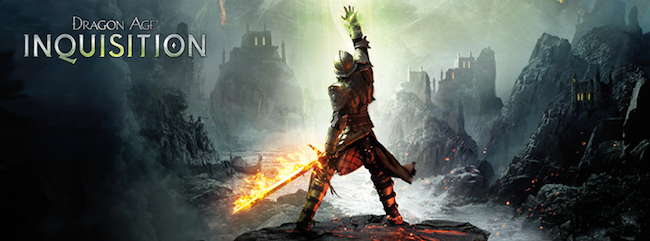
Dragon Age, once a side-project to BioWare’s popular Mass Effect series, is a franchise that quickly grew from zero to hero. The first game, Dragon Age: Origins, wasn’t a great looking game, even for the time, but the development team had promised fans that they were going to use the opportunity to go back to the roots of older titles such as Baulder’s Gate. In truth, that didn’t mean much to me as I hadn’t played them (I’m terrible, I know!), but I was still very intrigued by the “origins” aspect, as well as the twisted take on Tolkien-esque fantasy. What followed, however, was an experience that was a little clunky, average on the eyes, and yet so genuine in all the right places. It was kind of like that girl/boy you probably “should” have dated in high school, and I could not help but get swept up in its sincerity.
Our second outing together, Dragon Age: Origins – Awakening, delivered what I consider to be the greatest expansion of the last generation. A stand-alone 15-hour experience that introduced new plot and characters, while carrying across all progress and equipment from the original. It was an effort that puts 99% of post-launch DLC to shame. However, despite its critical success and popularity, this was not good enough for the franchise’s step-father, EA. Dragon Age II was expected to be better looking, faster-paced, more accessible, and to achieve all this in just 18 months; which is just unrealistic for an RPG. Needless to say, the result was superficially pleasing, but unsurprisingly lacked many of the original’s genuine qualities. Fans were not happy, and the future of the franchise seemed uncertain.

For all its flaws, there were still some great narrative ideas in Dragon Age II: one of which was the escalating issues between the templars and the mages. We might’ve had to wait over three and a half years to continue that story, but Dragon Age: Inquisition (DA:I) is here now, and it was worth the wait! It’s evident that both BioWare and EA listened to fan feedback, and, between themselves, found a resolve that resulted in a sequel that combines the best qualities of both its predecessors. Built from the ground up in the Frostbite 3 engine, it’s undeniably the best looking Dragon Age game to date. However, despite its superficial enhancements and accessibility, the series has also returned to selectable races, better tactical options, and large expansive areas to explore. Basically, it feels like Dragon Age again.
Inquisition picks up one year after the incident in Dragon Age II, that resulted in the destruction of the Kirkwall Chantry, and subsequently sent the templars and mages spiralling into full-scale war. Understandably, the conflict has been tearing the world of Thedas apart, so Devine Justinia V (Chantry Leader) had called for a conclave to resolve the war. However, something goes horribly wrong, killing everyone, and tearing a large breach in the sky from which demon’s start emerging. Our hero is the sole survivor of the explosion, with no memory, and a strange ability that grants the power to close the rifts between our world and the fade. Rescued by a new faction called “The Inquisition” (lead by some familiar faces), the player must earn support across Thedas to restore order and close the mysterious breach.
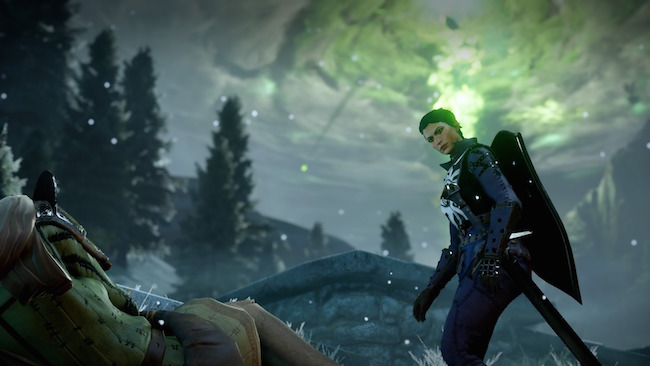
Before you begin, we recommend that you visit the Dragon Age Keep, which is an app that allows players to re-create/import their choices from the first two games. It’s very in-depth, and let us assure you, some decisions will absolutely alter the game world in meaningful ways. After the disappointment of Mass Effect 3, it’s a step in the right direction, and immediately does right by allowing players to choose their race; thus, altering the way that other characters perceive you. DA:I also excels at using fictional conventions to tackle real-world issues such as racism, sexuality, politics and religion. It’s an incredibly well-balanced story, filled with interesting lore, thrilling scenarios and well-written characters to create a believable world. In fact, it’s arguably some of BioWare’s strongest writing to date.
The approach to narrative in Inquisition works so well because it can be explored through multiple layers, giving players the option to dig as deep as they’re willing. Although, it’s important to note that it’s still very much about the character interactions; which are the highlight of any good BioWare game. In turn, this instalment introduces the largest playable cast to date, as well as a large number of supporting characters; many of which include familiar faces from previous games. I especially appreciated that not every important character had to be a “warrior,” which I found significantly diversified the personalities you could interact with this time. Furthermore, the story isn’t afraid to move in unexpected directions, providing lots of unique opportunities to explore the best and worst qualities of each character.
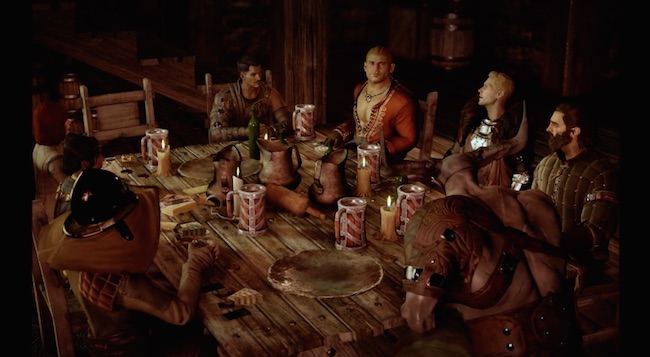
Choice is always a crucial factor when playing a BioWare game, and I feel this has been greatly improved with Inquisition. You’ll notice shortly after you begin that the dialogue options are much more “grey,” removing all emphasis of playing as a “paragon” or a “renegade.” In fact, just like in real life, there is no way to track your actions other than the consequences that follow. It’s going to be impossible to please every character, and in a way similar to The Walking Dead, you will receive prompts to notify you when someone approves or disapproves of your choices. Taking that idea further, though, you will also be required to choose your words carefully depending on who you’re interacting with, which is especially apparent in the country of Orlais; in which you should never speak candidly. The options you’re given are a lot of fun to experiment with, and this makes the dialogue feel much less “token” than in the past.
One of the more interesting components of DA:I is a meta-game where you need to build influence and power for The Inquisition; a task that is vital to your progression. Basically, The Inquisition levels up like its own character, which rewards players with unique perks. To do this, you must visit “The War Room,” a special area where you manage your influence on the world map, and send non-playable characters on missions for rewards. Each mission subsequently requires real-time to complete, but will vary depending on the strengths of the character you assign. Furthermore, you are also be required to build up a currency called “power,” which is a reward for completing quests, and necessary to unlock any new areas or major missions on the map. Personally, I really enjoyed this approach as it encourages players to slow down, explore the world, pursue other objectives, rather than powering through the main storyline.
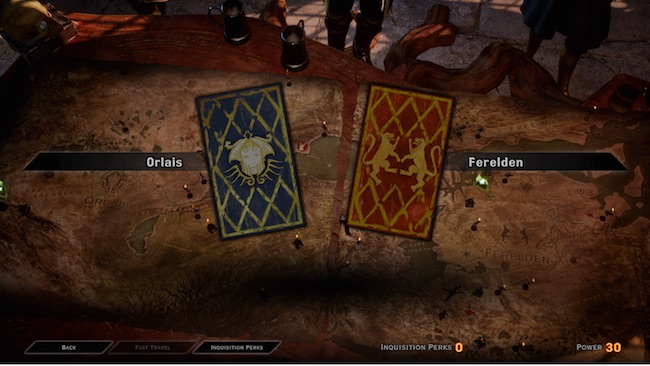
It was advertised prior to release that DA:I was going to be bigger than Origins and II combined, and that was no exaggeration. While not a “true” open-world experience, you still can’t help but be blown away by how big it is; we’re not far off Skyrim, to be honest. To clarify further, the world map is split between two countries: Ferelden and Orlais; each with their own selection of self-contained open-world areas to explore. Personally, I really liked this approach as it definitively highlights the contrast between level designs, while also avoiding the trap of becoming overwhelmed with side-quests. It’s very easy to manage as all your quests are sorted by region, or totally separated in the case they’re tied to the main plotline or a side story. I also think many fans will enjoy being able to finally visit the long spoken about Orlais, which clearly resembles the French Renaissance as opposed to the Medieval English design of Ferelden.
Customisation is a primary component of DA:I, with players starting out by choosing their race, class and appearance. What surprised me, however, is how approachable many of the primary systems are (specialisations, crafting, etc.), and how they slowly expand over time. For a game that takes at least 50-60 hours to complete, the pacing is quite superb as it’s still introducing new features well past the half-way point; as well as more in-depth options for those who want to play hard. In turn, I equally appreciated that DA:I respects your time by providing enough non-generic content to reduce the need for “grinding.” Assuming you have even a mildly curious nature, you will almost never be short on interesting things to do, or the amount of experience, loot and power you need in order to progress. Although, it’s so easy to get distracted; with enough optional content that could easily keep you going for 100+ hours.
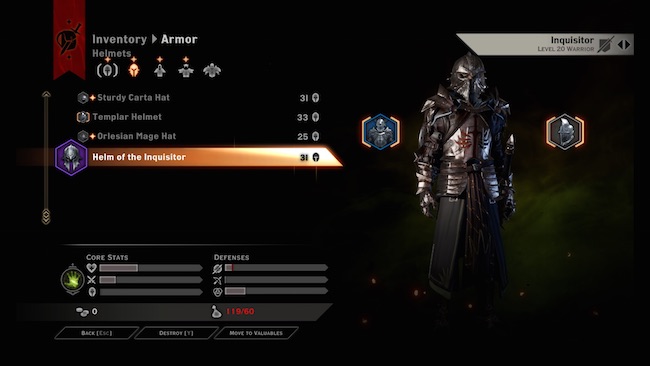
Mechanically speaking, the developers have tried to incorporate the best qualities of the previous games, to create a hybrid system that’s both approachable and empowering. For the most part, the combat feels fluid and stylish, much like DA:2 tried to accomplish, while still incorporating the tactical options that defined Origins. Its absence was a major point of criticism in DA:2, so it was good to see it return! The problem with the tactical view in the console version, however, is that everything is so awkwardly zoomed that it makes it somewhat unenjoyable to use for extended periods of time. I still found myself using it for scouting enemies and occasional micromanagement when things grew heated, which was handy, but the lock-on feature was almost entirely unusable. With that said, I am also aware that on the PC version, where this system has always worked most effectively, the same hindrances are not so prominent.
Exploration is more of a focus than it’s ever been for the series, taking a significant leap forward from the repetitive environments of DA:2. The world is unmistakably diverse, and there are so many things to see and do; such as capturing strongholds, solving puzzles and exploring dungeons. You can also get around more quickly by using mounts for the first time in the series, and it’s equally noteworthy that BioWare has finally added a jump button! Furthermore, despite being semi-open, you can still travel to places you probably shouldn’t yet, which are, of course, filled with enemies well above your level. What I like about this option is that the curiosity that leads to these places, forces players to genuinely strategise: resulting in smarter tactics rather than grinding. Dragons are the ultimate challenge, and the satisfaction you get from defeating one is almost unparalleled by any other foes I’ve encountered.
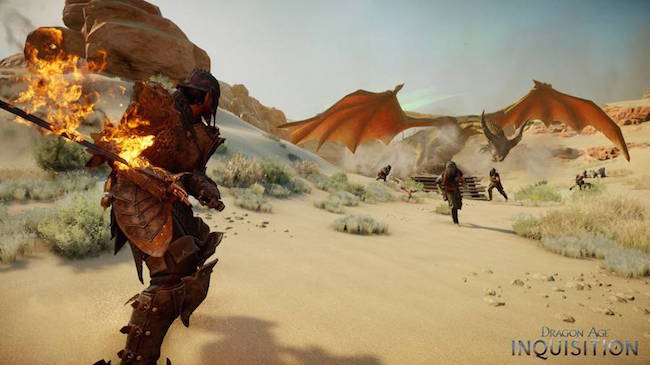
As I mentioned earlier, DA:I has been built from the ground up in the Frostbite 3 engine, which is the first genuinely great thing to come from EA’s adoptive parentage of the franchise. Regardless of your platform, it looks outstanding; opening with its incredibly robust character creator. It’s clear that faces were important to BioWare, given the amount of face-to-face dialogue, so there is a much less noticeable difference in quality between the main cast and NPCs. The characters themselves are all highly detailed, with lots of variances between the designs and textures of the clothing, armour, etc. There has also been a massive step forward in terms of the facial animations; with many of the characters looking a lot less like creepy talking dolls. Although, this is equally in part to the excellent voice work that’s impressive across the board. No matter the situation, I always felt my hero sounded equally as sophisticated as he did a badass.
In terms of visual design, the landscapes are some of my favourite of any recent RPG; in conjunction with its fantastic supporting soundtrack, of course. From lush green forests filled with ancient ruins to desolate deserts holding hidden treasures, I always felt as if I was on a grand adventure. Personally, I would have liked to have seen more cities, but the focus on natural landscapes and the contrasting style between Orlais and Ferelden works very well. Furthermore, the activity on the war table provides the feeling as if you’re covering a lot of memorable places, and an opportunity to learn about how the rest of the world has changed. My only problem with the presentation, at the time of writing, are the bugs and glitches: I had multiple incidents of dialogue breaking, sound cutting out during combat, as well as several major crashes (no data corruption, though!). It was mostly forgivable for a game this big, but it needs patching.
 Some of BioWare’s strongest writing to date
Some of BioWare’s strongest writing to date
 Well-developed and memorable characters
Well-developed and memorable characters
 Very approachable, yet deeply complex
Very approachable, yet deeply complex
 A remarkable amount of content to explore
A remarkable amount of content to explore
 Outstanding landscapes and world design
Outstanding landscapes and world design
 Tactical view feels awkward on consoles
Tactical view feels awkward on consoles
 Bugs and inconsistencies need patching
Bugs and inconsistencies need patching
Dragon Age: Inquisition is an improvement over its predecessors in almost every way, both combining and innovating upon the franchises best qualities. It’s a massive and beautiful world that begs to be explored, with enough quality content to keep casual players interested and the most hardcore consumed for months. I also really appreciate that it’s both approachable in its mechanics, as well as deeply complex for those who intend to play hard. In fact, I find little to fault without turning to nitpicking, but given the vast improvements, they’re easy to overshadow. Above all else, though, it’s the writing and characters which make this game so special, with enough fan service and callbacks to earlier games that could make Mass Effect blush. It’s not perfect as its still got bugs and inconsistencies, but above all else, it’s one of the most impressive returns to form I’ve seen in a long time, and I commend BioWare for their efforts.











